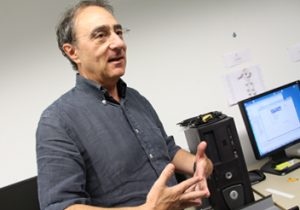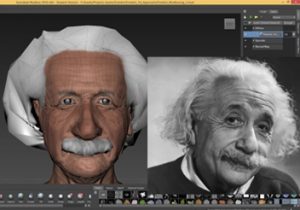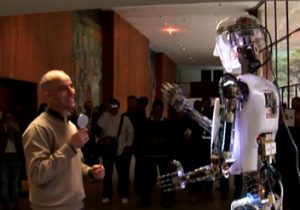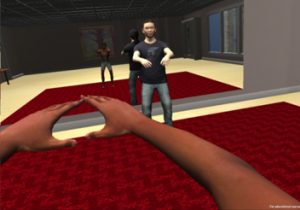“When you see yourself in a virtual body, you adopt some of its features”

Mel Slater, researcher at the Institute of Neurosciences, director of Event Lab and ICREA professor at the Department of Clinical Psychology and Psychobiology of the Faculty of Psychology of the University of Barcelona.
We interviewed Mel Slater, regarding the latest Advanced Grant he was given by the European Research Council (ERC) in the 2017 call. This is the fourth grant ERC awards to Slater, who already received another Advanced Grant and two Proof of Concept grants. He now tells us about the importance of his group, to which he gives five years of continuity during when they can do research in depth.
Which are your current main research lines?
We have been undertaking a Proof of Concept project over the last eighteen months, which is based on the idea that we can give better advice to friends than to ourselves. With this virtual reality project the same conversation you have with yourself becomes objective: you talk to another (fictional) person.
In the first experiment we carried out, we had two circumstances, in one of them you were talking to Sigmund Freud and in the other you talked to a copy of yourself. We scanned those people, and got precise representations of their bodies, so that when they entered the virtual reality they saw themselves and shared their problems (regarding family, partners…). Afterwards they listened to the advice and therefore could have a conversation with themselves, switching between two bodies; the others became Sigmund Freud. Everyone improves because it is useful to speak about the problem at least. But those who talked to Sigmund Freud improved a bit more, and this may be due the fact that he is known for solving personal problems.
The ERC Proof of Concept projects are not only about academic research, but they intend to be useful for all society. We want to bring this experience to business applications; the problem could be trying to improve the creativity or negotiation in a company. The chosen character could be a known business guru such as Elon Musk. We are collecting data from businesspeople and clinical psychologists to study these applications. These experiments are based on other researches that show how people adopt some features when they are represented in a virtual body. We have finished another study based on the same idea, we wanted to see if people’s cognitive process can be improved, so we represented Einstein or a neutral character. First, we gave them a series of cognitive tests to take, and after the virtual reality experiment they undergone others which were similar. Those represented as Einstein did better than those who had a neutral body, but the most interesting fact was that this only worked out with people with a low self-esteem. Therefore, if they were more confident nothing happened those with low self-esteem, once they were in Einstein’s body, raised their score.

Images of the condition of the experiment with Sigmund Freud.
How do you see the future of research on virtual reality?

The avatar used for Albert Einstein.
Since we started our first ERC grant, in 2009, the world of virtual reality has changed a lot, back then our equipment cost more than a million euros. There were two kind of equipment: one was in a big room, a cave, and the other was the head mountain display. We can do the same or even better, and the cost is about two thousand euros, so this is completely changing. Virtual reality used to exist in universities and some companies only, and now people can use it at home and at work.
Therefore, a challenge that can come up in the future is that no one knows what would happen if people used virtual reality many hours a week. It is important to understand the short-term and long-term effects, especially in kids, because this has never happened. We tried to raise money to do research on this issue, but we were not successful.
Another challenge is the level of accuracy, real life is full of people who speak, walk, many events occurring at the same time… and this has not been properly represented in virtual reality. We want to do so in the new project, “Moments in time in Immersive Virtual Environments” (MoTIVE).
Touch is another challenge. Virtual reality is great regarding vision and sound, but despite having great devices on touch, such as the simulation of sticking a needle onto some material, it has not been possible to create a general sense of touch such as the one in real life.
We are aware that when we experience virtual reality, this situation is not real, but what are the key factors to reach an immersive experience, which looks real?
The most important thing is that, when you perceive the world, you use your body in a similar way than in reality and you get the same kind of feedback. This is known as sensory-motor contingency, and we use it to sense things in our daily life through our body, for example, I can see something underwater when moving my body, I can look around… Thus, if virtual reality gets this perception of a full body, chances of you feeling inside the virtual world will increase. The simplest hypothesis for my brain is that I am where my perception system tells me I am. At a higher cognitive level, you can tell yourself that this is not true, but your perception goes fast and makes you feel such illusion.
Another aspect is plausibility. It is possible for you to feel you are in some place but you don’t believe any of the events that occur. Therefore, for instance, if I am inside the virtual reality and I am talking to a virtual human being and s/he ignores what I say, I will not believe in this virtual human. Plausibility is about to what extent you have that illusion of events being real, and it depends on whether you get a reaction or response to your actions. And last, things have to occur in real life too, they have to reach your expectations.
What applications do you thing virtual reality could have in our daily life?

The image shows Dr Javier Martínez Picado in the laboratory in Barcelona, talking to the journalist Nonny from la Peña, in Los Angeles. The journalist is under virtual reality, represented by the robot of our laboratory. She can see through the camera/eyes of the robot, and while she moves, the robot mimics her movements.
One of those we explored in other projects is traveling, instead of making a long journey to get to a meeting, which involves time, effort and money, I could stay in my office, use a head mounted display and feel I am with the other people in the meeting, it’s not like teleconferencing –where you see everything on a screen. We cannot do so yet, but in a future, when two people meet in virtual reality they will be able to see daily things with detail, like when someone blushes, breathes, or the movements that can tell someone is getting nervous.
Another application would be to rehearse situations. Let’s say I am afraid of public speaking, I could practise this with virtual reality and make the audience to be receptive or negative, to prepare all the possible situations. You can also practice with an emergency situation, for example, if there is a crowd and someone finds a bag with no name tag, emergency services have to act in a certain way in case it is dangerous or it is just a false alarm. Can you tell us about an example of how virtual reality can be used as a therapy?For example, when someone is afraid of heights, the clinical psychologist recommends to follow some exercises, but s/he does not know what the patient’s response will be. They can do these now with a head mounted display so that people respond in a real way. The psychologist can see what they do and can give them advice. Can a virtual reality experience get someone’s ideas and opinions to change?We see some implicit racism in these studies. The explicit one occurs when you really have that opinion, but regarding the implicit one, despite not having that belief, you behave in a certain way unconsciously. For example, if you interview people for a job, you may not be aware of it, but you can have a certain attitude towards a certain ethnicity. It has been proved that implicit bias can be reduced and this decrease lasts for at least a week.When two people get along, they tend to copy each other’s behaviour. We carried a study out -in which we had people under virtual reality with a black or a white body and they interacted with the other virtual character, who was either black or white. If I am represented with a black body and the other character is also black, I tend to copy his or her behaviour without being aware of it. This representation, called out-group person, seems to affect the level of implicit behaviour. We do not study the explicit level because these are university students who are not explicitly biased, I think it would be different in another country, since there are some countries with more or a deeper racism than here.
Can tell us about some ethical challenges virtual reality can bring in the future?

In the experiment on racism bias, the participant can see his/her body in first person and in the mirror as a black avatar, and has to follow the movements of a Tai Chi instructor.
We are aware of the ethical problems, we had a part of our work dedicated to ethical issues in the European Union projects. In the ERC projects we had an ethics advisor who gave us some advice on our experiments. Although we talk a lot about this issue, I have never faced any case of an ethical problem. We embody people in virtual bodies which are different to theirs and that could affect them in some way, but it has not happened. We monitor some of the participants and they always give positive feedback.
But, what problems can arise? I think we should work on the effects of aspects such as the view on addictions. There is not a legislation for virtual reality because it is an unknown field, changes happen fast and it is not quite spread among society, but it could become popular because it is cheaper now. We do not have enough data to make regulations yet.
What are the advantages of being part of the Institute of Neurosciences of the UB for your research?
Engineers, psychologists and neuroscientists take part in most of our projects. These come from different fields and this interdisciplinarity is useful, it allows us to see things from different perspectives and understand our research field better. That’s why I think that the fact that the Institute of Neuroscientists gathers people from different disciplines is extremely useful to share knowledge and think creatively.



No Comments